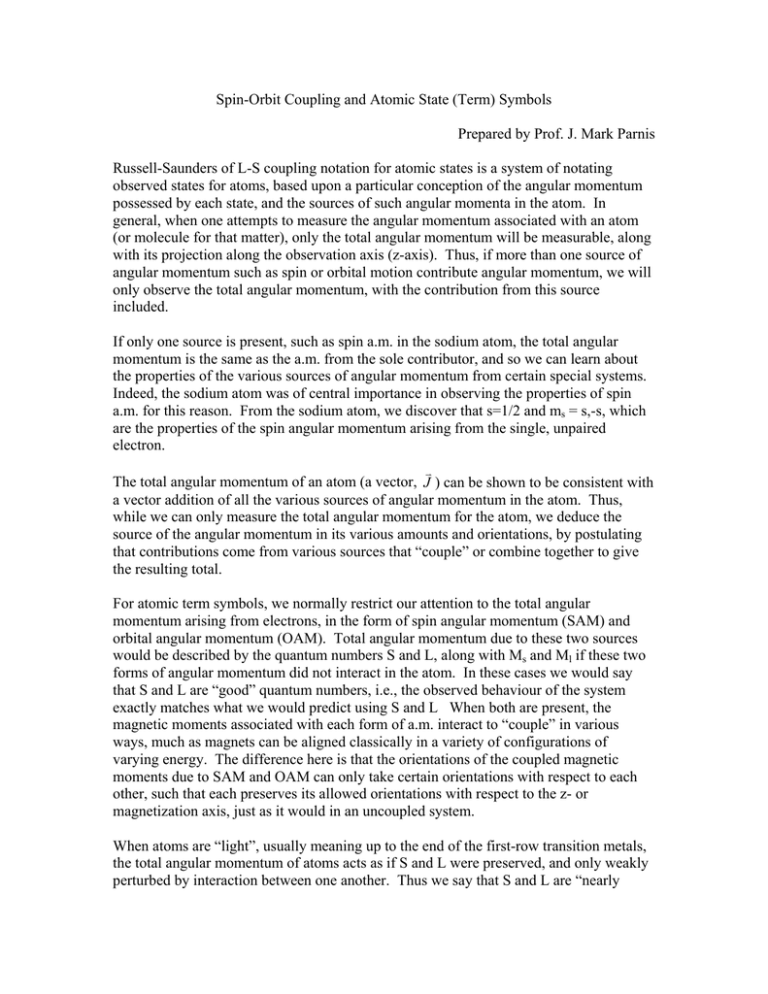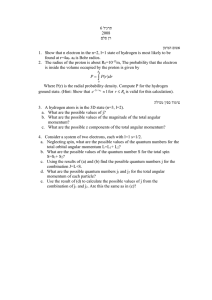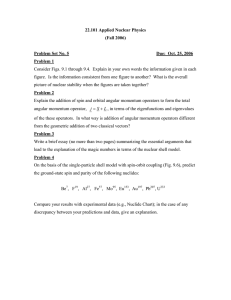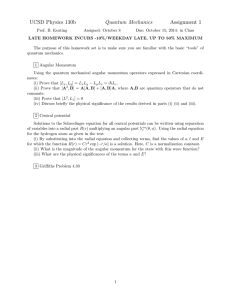Spin-Orbit Coupling and Atomic State (Term) Symbols
advertisement

Spin-Orbit Coupling and Atomic State (Term) Symbols Prepared by Prof. J. Mark Parnis Russell-Saunders of L-S coupling notation for atomic states is a system of notating observed states for atoms, based upon a particular conception of the angular momentum possessed by each state, and the sources of such angular momenta in the atom. In general, when one attempts to measure the angular momentum associated with an atom (or molecule for that matter), only the total angular momentum will be measurable, along with its projection along the observation axis (z-axis). Thus, if more than one source of angular momentum such as spin or orbital motion contribute angular momentum, we will only observe the total angular momentum, with the contribution from this source included. If only one source is present, such as spin a.m. in the sodium atom, the total angular momentum is the same as the a.m. from the sole contributor, and so we can learn about the properties of the various sources of angular momentum from certain special systems. Indeed, the sodium atom was of central importance in observing the properties of spin a.m. for this reason. From the sodium atom, we discover that s=1/2 and ms = s,-s, which are the properties of the spin angular momentum arising from the single, unpaired electron. v The total angular momentum of an atom (a vector, J ) can be shown to be consistent with a vector addition of all the various sources of angular momentum in the atom. Thus, while we can only measure the total angular momentum for the atom, we deduce the source of the angular momentum in its various amounts and orientations, by postulating that contributions come from various sources that “couple” or combine together to give the resulting total. For atomic term symbols, we normally restrict our attention to the total angular momentum arising from electrons, in the form of spin angular momentum (SAM) and orbital angular momentum (OAM). Total angular momentum due to these two sources would be described by the quantum numbers S and L, along with Ms and Ml if these two forms of angular momentum did not interact in the atom. In these cases we would say that S and L are “good” quantum numbers, i.e., the observed behaviour of the system exactly matches what we would predict using S and L When both are present, the magnetic moments associated with each form of a.m. interact to “couple” in various ways, much as magnets can be aligned classically in a variety of configurations of varying energy. The difference here is that the orientations of the coupled magnetic moments due to SAM and OAM can only take certain orientations with respect to each other, such that each preserves its allowed orientations with respect to the z- or magnetization axis, just as it would in an uncoupled system. When atoms are “light”, usually meaning up to the end of the first-row transition metals, the total angular momentum of atoms acts as if S and L were preserved, and only weakly perturbed by interaction between one another. Thus we say that S and L are “nearly good” or “pretty good” quantum numbers, which is to say, the observations that we make are consistent with S and L being good quantum numbers, but the exact energies of the states is slightly different from what we predict with S and L. In this case, (light atoms) we may endeavour to determine the values of S and L for the atom, and then couple them to get a resulting total angular momentum quantum number J, which is strictly preserved or “good”. The value of first determining S and L is that there is an obvious logic to the source of S and L which is not at all obvious when one considers J. For example, the sodium atom has no orbital angular momentum, so we can immediately say L=0. Furthermore, we know there is only one unpaired electron in sodium and, given that all filled shells contribute no net angular momentum (see below) we can immediately say S = s = 1/2. Unless you note that the only source of angular momentum from electrons in sodium is the spin of one electron, you would not be able to immediately note that J=S=1/2. For more complicated atoms, determination of S and L requires careful attention to detail, but direct determination of J is much more complicated, and so we determine J in parts. As well, since for light atoms, S and L are “nearly good” quantum numbers, many selection rules associated with them are still quite strongly adhered to, so it is of some practical value to know them. If present alone in an atom, or if considered to be uncoupled, SAM and OAM associated with a single electron show the analogous properties as total angular momentum, vis.: v L = l (l + 1)h and L z = ml h ml = l , l − 1, l − 2... − l v S = s ( s + 1)h and S z = m s h m s = s, s − 1, s − 2... − s however, since s=1/2 only, ms = ½, - ½ only. It is when more than one electron is contributing to the total angular momentum of the atom that the situation becomes more complicated. We must consider that each electron contributes spin and often orbital angular momentum (except s-orbital electrons), and the magnetic moments associated with these may interact for the same electron, or for different electrons in the atom. The total OAM for an atom is determined by scalar addition of the quantum number for the projection of the angular momentum vector on the quantization axis, ml. This is done, because direct addition of angular momentum via li vectors requires vector addition, which is relatively complicated. Therefore, we consider the sums obtained from all possible distinguishable electronic configurations for several electrons to obtain ML, and then deduce the value of L that gave rise to the various components ML found, knowing that there will be families of ML values associated with each L value, since ML = L, L-1, L-2,…-L. The same applies for determination of S, which is determined via Ms values. Traditionally, the spin part is expressed as a “spin multiplicity” 2S+1, which accounts for the number of spin-orbit states found in most cases (e.g. when L=2 and S=1, we get J = 3,2, and 1, i.e. three states in total, which matches 2S+1). It was observed that the behaviour of light atoms could be best understood if it was assumed that the interaction between both the magnetic moments associated with spin from different electrons and the magnetic moments due to orbital angular momentum from different electrons couple very strongly, such that individual quantum numbers for single electrons si and li are “bad” quantum numbers, meaning they no longer account for what we observe in a meaningful way. In contrast, magnetic moments due to spin and orbital angular momentum of a single electron interact or couple rather weakly (for light atoms), and in a first approximation can be considered to not interact at all initially in doing the angular momentum accounting for the atom. This is the basis of RussellSaunders coupling, which first calculates the total SAM and OAM for the atom, and then couples the magnetic moments associated with these two “almost good” quantum numbers to arrive at the “good” quantum number J. In the case of heavy atoms, the coupling between magnetic moments associated with SAM and OAM of individual electrons is much greater, stronger than the spin-spin or orbital-orbital interactions that dominate for light atoms. In this case, it makes more sense to couple si and li for each individual atom to arrive at jj, the total angular momentum associated with each electron. Subsequently, the individual ji quantum numbers (now these are nearly good) are coupled to recognise the weak interaction between magnetic moments due to total angular momentum of individual electrons in heavy elements, to give the same J, the “good” quantum number for total angular momentum. (Hence, the name j-j coupling for this scheme, which is not covered further here). In the Russell-Saunders or L-S coupling scheme, we represent the various energy states associated with allowed interactions of SAM and OAM by the term symbol, which has the following structure: spin multiplicity Total OAM symbol total AM quantum number J = (2S+1) LJ Remember that only J is a “good” quantum number, so ultimately it is the little J value in the bottom right that is the real “result” of L-S coupling. The L and S parts are however useful for predicting and understanding properties that are approximately predicted by these “nearly good” quantum numbers, such as some selection rules. In these cases, the heavier the atom, the worse L-S coupling is at describing the system, the “worst” L and S become as quantum numbers, and the more selection rules based on L and S are violated. The values of J that are allowed for any atom are given by J = |L+S|, |L+S-1| … |L-S|. Therefore, if we can know L and S, we can know the allowed J values or states immediately. Our job is to determine all the possible values of L and S for a given electronic configuration. Let’s start with simple systems to get used to the idea of how to do L-S coupling: Case A: No unpaired electrons, all electrons are in full shells. For example, consider the electrons in a ns2 filled s shell. We deduce the value of L based upon scalar addition of the z-component of each electron under consideration. In this case we have: ml(1) 0 ml(2) 0 ML 0 L 0 ms(1) 1/2 ms(2) -1/2 MS 0 S 0 J 0 Here we add the z-components of each of the orbital contributions from each electron, M L = ∑ ml (i ) , but for s-electrons, there is no orbital angular momentum, so mz i = 0 only for each electron, corresponding to a total ML= 0 which is only found when L=0. To be in the same orbital, the electron must have different spins, so the total projection of the spin angular momentum is given by MS = 0, corresponding to a S=0 state. The term symbol for a state with an ns2 configuration is therefore 1S0. It is straightforward to convince yourself that you will obtain this result for any filled shell, since there will always be equal numbers of electrons with ms= ½ and ms = - ½ , giving a sum of ms = 0. Also, there will always be as many ml = +2 as –2, +1 as –1, etc. for a filled shell, so the total ML= 0 always. Look at an np6 filled shell as an example: ml(1) 1 ms(1) 1/2 ml(2) 1 ms(2) -1/2 ml(3) 0 ms(3) 1/2 ml(4) 0 ms(4) -1/2 ml(5) -1 ms(5) 1/2 ml(6) -1 ms(6) -1/2 ML 0 Sz 0 L 0 S 0 Here the various orbital angular momenta give a net momentum of 0, as manifest by the value of ML= 0, which only corresponds to L=0. Likewise the sum of the sz components as represented by the sum of ms gives a net MS=0, which can only correspond to S=0. When there is an unfilled shell in the atom, the contribution to the total angular momentum is non-zero, and we need to consider the situation in detail, ignoring contributions from all other filled shells in the atom. For example, let’s revisit the sodium atom to reinforce our approach: ml(1) 0 0 ML 0 0 L 0 0 ms(1) 1/2 -1/2 Ms 1/2 -1/2 S 1/2 1/2 We see there are two distinguishable states in the presence of a magnetic field, with Ms = ½ or – ½ . We could actually cause a transition between these two states with microwaves in an ESR spectrometer to demonstrate their presence. Let’s consider a Sc atom, with an [Ar] 4s2 3d1 electronic configuration: ml(1) 2 2 1 1 0 0 -1 -1 -2 -2 ML 2 2 1 1 0 0 -1 -1 -2 -2 L 2 2 2 2 2 2 2 2 2 2 ms(1) ½ -½ ½ -½ ½ -½ ½ -½ ½ -½ Ms ½ -½ ½ -½ ½ -½ ½ -½ ½ -½ S ½ ½ ½ ½ ½ ½ ½ ½ ½ ½ Each Ml value is present in the table with two values of Ms, corresponding to a value of S= ½ (Ms = ½ , - ½ ), and together they correspond to the five “microstates” associated with an L=2 configuration, where Ml = 2,1,0,-1,-2. All entries in the table are accounted for this way. We conclude that J can equal 2+ ½. 2 + ½ -1 ….2- ½ , which corresponds to 5/2 and 3/2 only. Finally we conclude there are two possible states that can arise from this electronic configuration, 2D5/2 and 2D3/2. Notice that the number of states is directly determined by the number of J values, which themselves reflect the number of distinct and allowed ways in which the L and S angular momenta can couple through their magnetic moments. Let’s conclude with two cases where there are more than one unpaired electrons in a given shell: Carbon atom [He] 2s2 2p2: ml(1) 1 1 1 1 1 1 1 1 1 0 0 0 0 0 -1 ml(2) 1 0 0 0 0 -1 -1 -1 -1 0 -1 -1 -1 -1 -1 ML 2 1 1 1 1 0 0 0 0 0 -1 -1 -1 -1 -2 L 2 1 2 1 1 1 2 1 1 0 1 1 2 1 2 ms(1) ½ ½ ½ -½ -½ ½ ½ -½ -½ ½ ½ ½ -½ -½ ½ ms(2) -½ ½ -½ ½ -½ ½ -½ ½ -½ -½ ½ -½ ½ -½ -½ Ms 0 1 0 0 -1 1 0 0 -1 0 1 0 0 -1 0 S 0 1 0 1 1 1 0 1 1 0 1 1 0 1 0 Here we note all the distinguishable states that would have different energies in the presence of an external magnetic field, the so-called microstates. Note that the electrons in different orbitals are considered to be distinguishable, but those in the same orbital are not. We now set out to deduce what states give the distribution of microstates found above, i.e., what values of L and S are implied. We start with the highest value of Ml = 2, which implies that there must be a set of 5 microstates with Ml = 2,1,0,-1,-2, arising from an L=2 (D) state. However note that for the ML= 2 microstate, that Ms= 0, implying S=0 (a singlet state). Therefore we need to choose five microstates that have Ms = 0, and values of Ml = 2,1,0,-1,-2. These are notated in bold and blue above. These are the components of a 2D state. Once we eliminate these microstates, the microstate with the highest value of Ml remaining has Ml = 1 and Ms=1,0, and -1. These correspond to a state with L=1 (a P state) and S=1 (a triplet state). Each component of L, i.e. ML = 1,0,-1 must have three MS = 1,0,-1 components. These nine microstates are given in green above. These are the components of a 3P state. Once these microstates are eliminated, there remains only one state with ML = 0 and MS = 0, which correspond to the only component of an L=0 (S state), S=0 (singlet) state, which corresponds to a 1S state. Having established the possible values of L and S, the “nearly good” quantum numbers that would be good if there were no interaction between SAM and OAM, we can deduce the possible values of J. the good quantum number in the presence of spin-orbit coupling. r v v Recall that J = L + S , and that J = |L+S|, |L+S-1|, …|L-S|. Therefore we have, for a 2D state, J = 2+2, 2+2-1, …|2-2|, which gives 2,1, and 0. Therefore, we have three spin-orbit states with symbols 2D2, 2D1, and 2D0. Note that a triplet state (2S+1)=3, yields three different states in the presence of spin-orbit coupling, which is one reason why knowing the spin multiplicity is useful. (There is one exception, which is the 2S state for which J = 1 only, i.e., there is only one value of J possible, even though it is a “triplet” state.) The other two states are determined in the same way: L Symbol S Multiplicity J (2S+1) 2 D 0 1 2 1 P 1 3 2,1,0 0 S 0 1 0 Symbol 1 3 D2 P2, 3P1, 3P0 1 S0 Finally, let’s look at the Sc atom, a d2 configuration atom: ml(1) 2 2 2 2 2 2 2 2 2 2 2 2 2 2 2 2 2 1 1 1 1 1 1 1 ml(2) 2 1 1 1 1 0 0 0 0 -1 -1 -1 -1 -2 -2 -2 -2 1 0 0 0 0 -1 -1 ML 4 3 3 3 3 2 2 2 2 1 1 1 1 0 0 0 0 2 1 1 1 1 0 0 L 4 3 4 3 3 3 4 3 3 3 4 3 3 3 4 3 3 2 1 2 1 1 1 2 ms(1) ½ ½ ½ -½ -½ ½ ½ -½ -½ ½ ½ -½ -½ ½ ½ -½ -½ ½ ½ ½ -½ -½ ½ ½ ms(2) -½ ½ -½ ½ -½ ½ -½ ½ -½ ½ -½ ½ -½ ½ -½ ½ -½ -½ ½ -½ ½ -½ ½ -½ Ms 0 1 0 0 -1 1 0 0 -1 1 0 0 -1 1 0 0 -1 0 1 0 0 -1 1 0 S 0 1 0 1 1 1 0 1 1 1 0 1 1 1 0 1 1 0 1 0 1 1 1 0 1 1 1 1 1 1 0 0 0 0 0 0 0 0 0 -1 -1 -1 -1 -1 -2 -1 -1 -2 -2 -2 -2 0 -1 -1 -1 -1 -2 -2 -2 -2 -1 -2 -2 -2 -2 -2 0 0 -1 -1 -1 -1 0 -1 -1 -1 -1 -2 -2 -2 -2 -2 -3 -3 -3 -3 -4 1 1 3 4 3 3 0 1 1 2 1 3 4 3 3 2 4 3 3 3 4 -½ -½ ½ ½ -½ -½ ½ ½ ½ -½ -½ ½ ½ -½ -½ ½ ½ ½ ½ -½ ½ ½ -½ ½ -½ ½ -½ -½ ½ -½ ½ -½ ½ -½ ½ -½ -½ -½ ½ -½ -½ -½ 0 -1 1 0 0 -1 0 1 0 0 -1 1 0 0 -1 0 0 1 0 -1 0 1 1 1 0 1 1 0 1 0 1 1 1 0 0 1 0 0 1 1 1 0 Here we have picked off the following microstates, by the same logic: Begin by noting the state with the highest ML value = 4. This state has MS = 0, so we are expecting a singlet state with ML = 4,23,2,1,-1,-2,-3,-4. Each value of ML will contribute one microstate, since S=0, for a 1G state. Microstates are notated above in blue. Next, in what remains, the highest value of ML is +3, with the highest MS value = 1. This implies an L=2 state with ML = 3,2,1,0,-1,-2,-3, and S=1, for MS = 1,0,-1 for each ML value, for a total of 6x3=18 microstates. These are notated in red above, for a 3F state. The highest remaining value of ML is 2, for which MS = 0 only. This implies a state with L=2 or ML = 2,1,0,-1,-2 and S=0, i.e. a 1D state, notated in green above. Now the next highest remaining value of ML =1 with MS= 1,0,-1 components. This corresponds to an L=1, S=1 state, 3P, as notated in pink. This leaves only the state with ML = 0 and MS = 0, i.e. a 1S state, notated in orange We can now determine the L-S coupled spin-orbit states by considering the possible values of the total angular momentum quantum number J = |L+S|, |L+S-1|, |L+S-2|,..|L-S| L Symbol S 4 3 2 1 0 G F D P S 0 1 0 1 0 Multiplicity (2S+1) 1 3 1 3 1 J Symbol 4 4,3,2 2 2,1,0 0 1 G4 F4, 3F3, 3F2 1 D2 3 P2, 3P1, 3P0 1 S0 3 The remaining situations that might be commonly encountered may be determined in an analogous fashion. Note that you may determine the same result in a more compact way by only considering one of the spin components of any given ML value, if you are careful: Singlet microstates for d2: ml(1) 2 2 2 2 2 1 1 1 1 0 0 0 -1 -1 -2 ml(2) 2 1 0 -1 -2 1 0 -1 -2 0 -1 -2 -1 -2 -2 ML 4 3 2 1 0 2 1 0 -1 0 -1 -2 -2 -3 -4 L 4 4 4 4 4 2 2 2 2 0 4 4 2 4 4 ms(1) ½ ½ ½ ½ ½ ½ ½ ½ ½ ½ ½ ½ ½ ½ ½ ms(2) -½ -½ -½ -½ -½ -½ -½ -½ -½ -½ -½ -½ -½ -½ -½ Ms 0 0 0 0 0 0 0 0 0 0 0 0 0 0 0 S 0 0 0 0 0 0 0 0 0 0 0 0 0 0 0 Triplet microstates for d2, MS=1 component only ml(2) ML L ms(1) ml(1) 2 1 3 3 ½ 2 0 2 3 ½ 2 -1 1 3 ½ 2 -2 0 3 ½ 1 0 1 1 ½ 1 -1 0 1 ½ 1 -2 -1 3 ½ 0 -1 -1 1 ½ ms(2) ½ ½ ½ ½ ½ ½ ½ -½ Ms 1 1 1 1 1 1 1 1 S 1 1 1 1 1 1 1 1 0 -1 -2 -2 -2 -3 3 3 ½ ½ -½ -½ 1 1 1 1 Taken horizontally, and not explicitly notating ms(1), ms(2), MS, and we can make the calculation even more compact. Note that each horizontal row is now associated with a particular value of ML, as noted in the leftmost column: d2 triplet microstates (only the MS = 1 component notated), giving 3G, 3P 2 1 0 -1 -2 ML U U U U U U U U U U 3 2 1 U U U U U 0 1 U -1 0 U U U -3 U -2 -1 d2 singlet microstates, giving 1G, 1D, 1S states 2 1 0 -1 -2 ML UD U D U U U UD U D D D 4 3 2 1 U U UD U D D D 0 2 1 0 D -1 0 -1 U D -2 UD U D -2 -3 UD -4 There is no more compact way to do this that I am aware of! Possible values of J need to be determined in the same way as was done earlier, i.e. J= |L + S|, | L + S – 1|, …| L – S|.





